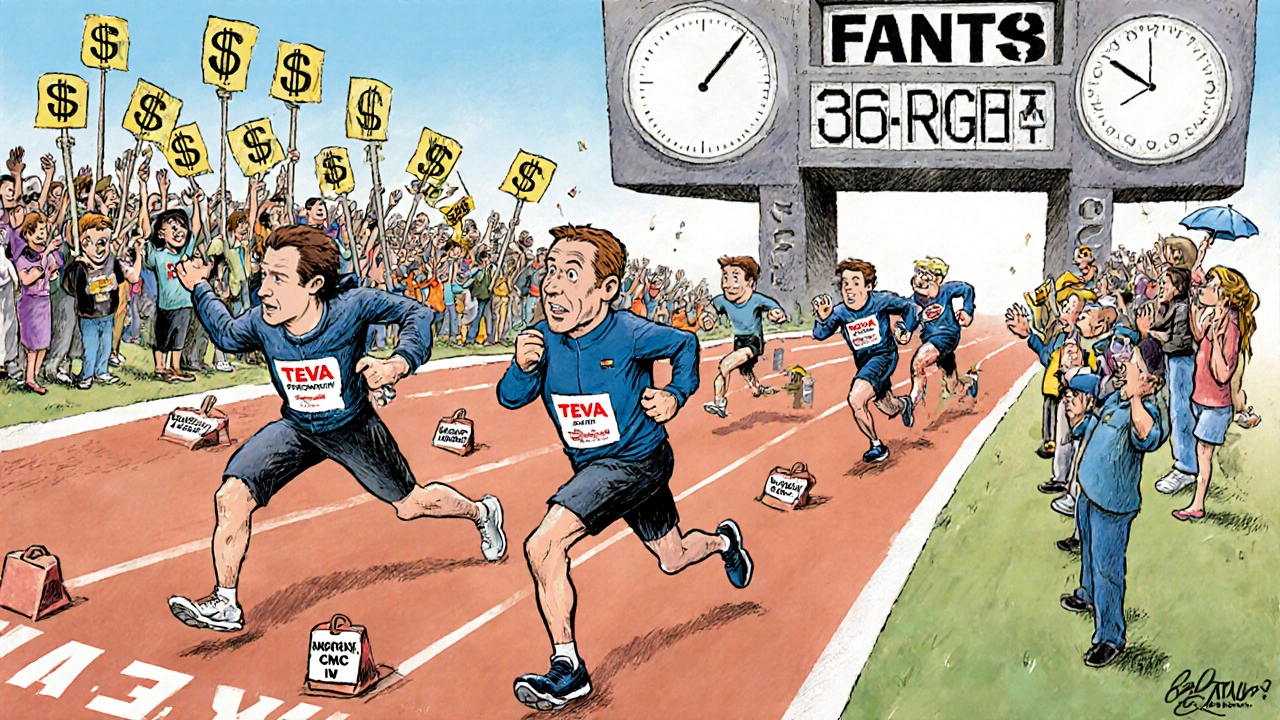The ANDA process is the legal gateway for generic drug manufacturers to bring affordable versions of brand-name medications to market in the United States. It’s not a shortcut-it’s a carefully structured legal and scientific framework designed to ensure that generics are just as safe and effective as their brand-name counterparts, without forcing companies to repeat expensive clinical trials. This system, born out of the Hatch-Waxman Act of 1984, has saved U.S. consumers over $2.2 trillion in the last decade by enabling competition. But getting an ANDA approved isn’t just about submitting paperwork. It’s about meeting strict legal, technical, and regulatory standards enforced by the FDA.
What the Hatch-Waxman Act Really Changed
Before 1984, generic drug makers had to prove a drug’s safety and effectiveness from scratch, just like the original brand. That meant spending billions and waiting over a decade to get approval. The Hatch-Waxman Act flipped the script. It allowed generic companies to rely on the FDA’s prior findings for the brand-name drug, known as the Reference Listed Drug (RLD). In return, brand-name companies got extended patent protection and five years of data exclusivity. This wasn’t just a policy tweak-it was a bargain between innovation and access. The law balanced the need for new drugs with the public’s need for low-cost alternatives.Today, 90% of prescriptions in the U.S. are filled with generics. But that doesn’t mean the path to approval is easy. The legal requirements are detailed, rigid, and often unforgiving. One missing document, one flawed bioequivalence study, or one incorrect patent certification can delay approval for years.
Core Legal Requirements for an ANDA Submission
To even be considered for review, an ANDA must meet five non-negotiable legal and scientific criteria set by the FDA:- Identical active ingredient: The generic must contain the same active pharmaceutical ingredient (API) as the RLD. No substitutions. No alternatives. Even minor differences in salt forms require a suitability petition.
- Same dosage form, strength, route, and use: If the brand is a 10mg tablet taken orally once daily, the generic must match exactly. Changing the form to a capsule or altering the dosing schedule requires a different pathway, like 505(b)(2).
- Proven bioequivalence: The generic must deliver the same amount of drug into the bloodstream at the same rate as the RLD. The FDA requires pharmacokinetic studies showing that the 90% confidence interval for Cmax (peak concentration) and AUC (total exposure) falls within 80-125% of the brand. This isn’t a suggestion-it’s a legal requirement under 21 CFR 320.24.
- Identical labeling: The generic’s prescribing information must match the RLD’s, except for minor differences like the manufacturer’s name or patent information. You can’t add claims the brand doesn’t have.
- Comprehensive CMC documentation: Chemistry, Manufacturing, and Controls (CMC) data must prove the generic is made the same way, with the same quality controls. This includes detailed descriptions of the manufacturing process, equipment, testing methods, and stability data showing the drug won’t degrade over time.
Failure on any one of these points means the FDA will issue a Refuse-to-Receive (RTF) letter. According to FDA data from 2022, 28% of RTF decisions were due to incomplete bioequivalence protocols, and 23% were because of insufficient CMC information. These aren’t minor oversights-they’re legal failures.
Submission Rules and Fees
The ANDA isn’t just a document-it’s a structured electronic package. All submissions must be in eCTD format, following the FDA’s 15-module template. You can’t just email a PDF. You must use Form FDA-356h for the application and Form FDA-3674 for user fees.In fiscal year 2024, the fee for a new ANDA was $129,500. That’s not optional. It’s mandated under the Generic Drug User Fee Amendments (GDUFA). There’s also a $5,000 fee for any major changes after approval, called a prior approval supplement. These fees fund the FDA’s review process, and they’re non-refundable-even if your application is rejected.
Manufacturing must follow Current Good Manufacturing Practices (cGMP). The FDA inspects every facility that produces the generic drug-whether it’s in Ohio, India, or China. In 2022, 68% of FDA Form 483 observations (inspectional violations) were at overseas facilities. If your plant fails inspection, your ANDA is dead.
Patent Certification: The Legal Minefield
One of the most complex parts of the ANDA process is patent certification. You must certify one of four things about the patents listed in the FDA’s Orange Book:- Paragraph I: No patent listed
- Paragraph II: Patent has expired
- Paragraph III: Patent will expire on a specific date-your product will launch then
- Paragraph IV: Patent is invalid, unenforceable, or won’t be infringed
Paragraph IV certifications are the most controversial. Filing one triggers a 30-month stay on approval if the brand-name company sues for infringement. That means even if your drug is perfect, you might wait two and a half years just to get into court. Teva’s generic version of Advair Diskus faced three complete response letters and a 42-month review timeline-mostly because of device testing and patent litigation.
Brand companies have used patent thickets-filing dozens of minor patents-to delay generics. Between 2015 and 2020, they filed 1,450 such patents on existing drugs. The CREATES Act of 2019 was passed to stop brand companies from blocking access to samples needed for testing, but it’s still a major hurdle.
Complex Generics: Where the System Gets Stuck
Not all generics are created equal. A simple tablet? Straightforward. An inhaler, a topical cream, or an injectable suspension? That’s a different story. These are called complex generics, and they make up 35% of pending ANDAs. The FDA approved only 42% of these on first review in 2022, compared to 78% for conventional generics.Why? Because bioequivalence is harder to prove. For an inhaler, you’re not just measuring blood levels-you’re measuring how much drug reaches the lungs. For a topical product, you’re measuring skin absorption. The science is evolving, and the FDA’s guidance is still catching up. In September 2023, they released a draft guidance for locally acting GI drugs, a long-overdue update.
Companies that succeed with complex generics invest heavily in pre-ANDA meetings with the FDA. In 2022, there were 1,842 such meetings. These aren’t casual chats-they’re formal sessions where you present your plan, get feedback, and avoid costly mistakes. One regulatory affairs specialist on Reddit said their company lost three ANDAs because they didn’t validate the container closure system properly. That’s not a technical glitch-it’s a legal failure.

Who’s Winning and Who’s Struggling
Teva, Sandoz, Amneal, and Mylan dominate the generic market, controlling nearly 50% of U.S. sales. But smaller companies are breaking through too. Lupin Limited got approval for a generic version of Jardiance in just 9.5 months-thanks to a clean application and full CMC documentation.What separates the winners? They don’t cut corners. They hire certified regulatory affairs professionals (RAC), who earn $125,000 on average. They use specialized consultants. They invest in training. The FDA offers 12-15 training sessions a year at $450 each. Many companies skip it-then pay ten times more later.
The approval rate for original ANDAs was 78.3% in 2022. That sounds high-until you realize it means nearly one in four applications get rejected outright. The average review time is 36 months, up from 30 months in 2015. The FDA’s GDUFA III goals aim to cut that to 10 months for standard ANDAs by 2027. But complex generics? They’re still stuck at 30+ months.
What You Need to Know Before Starting
If you’re thinking about launching a generic drug, here’s what you need to do first:- Find the RLD in the FDA’s Orange Book. There are over 20,000 approved products listed.
- Check patents and exclusivity periods. Don’t file until you’re legally clear.
- Design a bioequivalence study that meets FDA guidance. Don’t guess-follow the 2023 bioequivalence document exactly.
- Build a cGMP-compliant facility. Overseas manufacturing is cheaper, but riskier.
- Prepare your CMC section like your life depends on it. It’s the most common reason for rejection.
- Consider a pre-ANDA meeting. It costs time and money, but it can save you years.
The ANDA process isn’t a sprint. It’s a marathon with legal landmines. But for those who get it right, the payoff is massive. Generics account for 90.5% of prescriptions but only 18.1% of drug spending. That’s the power of this system. It works-when the rules are followed.
What is the main purpose of the ANDA process?
The main purpose of the ANDA process is to allow generic drug manufacturers to gain FDA approval for their products by proving they are therapeutically equivalent to a brand-name drug, without repeating costly and redundant clinical trials. This lowers drug costs for consumers while maintaining safety and efficacy standards.
Can a generic drug have a different inactive ingredient than the brand?
Yes, inactive ingredients (like fillers, dyes, or preservatives) can differ between a generic and the brand-name drug. However, these differences must not affect the drug’s safety, effectiveness, or bioavailability. If they do, the FDA may require additional testing or reject the application.
How long does it take to get an ANDA approved?
The average review time for a standard ANDA is 36 months, though the FDA aims to cut this to 10 months under GDUFA III by 2027. Complex generics, like inhalers or injectables, often take 30+ months. Delays can happen due to patent litigation, incomplete submissions, or manufacturing issues.
What happens if my ANDA gets rejected?
If your ANDA is rejected, the FDA will issue a complete response letter outlining deficiencies. You can respond with additional data or resubmit the application. However, you’ll need to pay another user fee, and the review clock resets. Many companies spend millions trying to fix one mistake-like inadequate CMC data or a flawed bioequivalence study.
Do I need to test my generic drug on patients?
No, you don’t need to conduct full clinical trials on patients. The ANDA process relies on bioequivalence studies, which typically involve 24-36 healthy volunteers. These studies measure how quickly and completely the drug enters the bloodstream compared to the brand-name version. This is legally sufficient under the Hatch-Waxman Act.
Is the ANDA process the same worldwide?
No. The ANDA process is specific to the U.S. FDA. Other countries have their own systems: Health Canada uses the Abbreviated New Drug Submission (ANDS), the European Medicines Agency uses the Generic Medicinal Product Application, and India has its own guidelines. While many follow similar principles, the legal requirements, fees, and timelines vary significantly.



mike tallent
Just want to say this post is 🔥. The ANDA process is wild when you think about it - we’re talking about a system that lets a $200 brand drug become a $5 generic, and it all hinges on some bioequivalence curves and a 129k fee. 🤯 The FDA’s not playing around - one typo in the CMC section and your whole project goes to hell. Kudos to the folks who actually get this right.